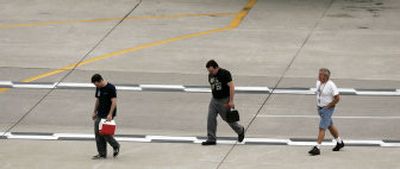Strikes fade as union tool

NEW YORK – “Strikes in July and August!” flashes the online ad, a pitch to recruit replacement nurses. “Apply now!”
When Northwest Airlines Corp. replaced its striking mechanics this past week, the move drew wide attention as a potential watershed moment: Could an employer replace scores of its highly skilled workers wholesale?
But the reality – hinted at by ads like this one from Healthcare Contingency Staffing Services Inc., which supplies replacement nurses to hospitals during strikes – is that many businesses have already figured out a variety of ways to swap or substitute for employees, either to cover in a short-term crisis or permanently.
It’s a reality workers will have to get used to, labor experts say.
The Northwest strike is in the spotlight because it comes during tough times for both the airline industry and for organized labor. But in many ways, it’s emblematic of larger changes, reflecting U.S. employers’ moves in recent years to increase their flexibility and cut costs through outsourcing, offshoring, contract labor and temporary hiring.
“It’s kind of humbling,” said Michael LeRoy, a professor of industrial relations at the University of Illinois who studies the use of replacement workers. “If you ask yourself, can I be replaced, lots of times you have to answer, yeah, I can be.”
That trend has been reshaping the airline industry for several years now, as carriers pare away pieces of their business and turn them over to outside companies.
United Airlines, for example, turned over cargo handling at its larger U.S. hub airports to Swissport International Ltd. in 2003. The move saves the carrier, a unit of bankrupt UAL Corp., about $100 million a year. The workers hired by Swissport earn about $10 an hour, roughly half what many of the unionized airline counterparts made to do the same work.
Swissport, based in Zurich, Switzerland, now provides a number of airlines with services ranging from fueling to aircraft maintenance at 51 U.S. airports.
But Northwest’s carefully planned recruitment of replacement mechanics is noteworthy because the workers in question are highly skilled. That makes them more difficult to replace. In the past, specialized skills were one of workers’ best means of job protection. By week’s end, though, Northwest was talking of giving permanent jobs to its replacements, and locking out the union.
Even as recently as five or six years ago, at the apex of a very tight labor market, many workers in white-collar, skilled jobs believed they were insulated from the uncertainty then enveloping workers in some relatively unskilled manufacturing businesses.
But the past few years have shown that seemingly any job – from computer programming to architecture to reading X-rays – can be done by somebody else cheaper, often overseas.
It’s a sign of the times, LeRoy says, that the class he teaches on employment law now includes a unit on the contingent work force, a subject that was barely a footnote a few years ago.
“You have lots of different ways that jobs are threatened these days,” said John Budd, a professor of human resources at the University of Minnesota.
That was obvious to many unions long before the Northwest strike. When air traffic controllers walked off the job in 1981, President Reagan defied the union and sent in replacements. The government’s success in facing down the strikers proved to many observers that, even when workers on the picket lines are highly skilled, they can be replaced.
The two decades since have coincided with a dramatic decline in the number of big strikes. There were 235 strikes that each involved more than 1,000 workers in 1979. Last year, there were just 17 such walkouts.
But some employers have continued to use replacements, or the threat of replacements, as a strike-battling strategy.
The practice has inflamed tensions in a number of strikes by nurses who, unlike airline workers, are in short supply just about everywhere. But a few firms have exploited that niche, recruiting nurses from around the country, and flying them in to cities as backup troops for hospitals and nursing homes.
By all accounts, the use of replacements has stretched out the length of the nursing strikes by allowing the hospitals to resist nurses whose bargaining position would otherwise be hard to beat.
“The whole point of a strike is to slow down operations and make it hard for a hospital to do business so they feel it’s worthwhile for them to settle,” said David Schildmeier, a spokesman for the Massachusetts Nursing Association, the union representing many of that state’s nurses. “The industry is using (replacement) strikebreakers as a chance to try and break the nurses.”
He cites a pair of strikes in Massachusetts in 2000 and 2001 – the latter stretching 103 days – in which hospitals’ employment of replacements allowed them to keep operating without giving in to unions.
When those strikes ended, the regular nurses had jobs to go back to. But unlike nurses, aircraft mechanics no longer have the protection offered by a tight labor market. The layoffs and cutbacks made by the airlines in the past few years have left a surplus of highly qualified mechanics and other workers on the sidelines.